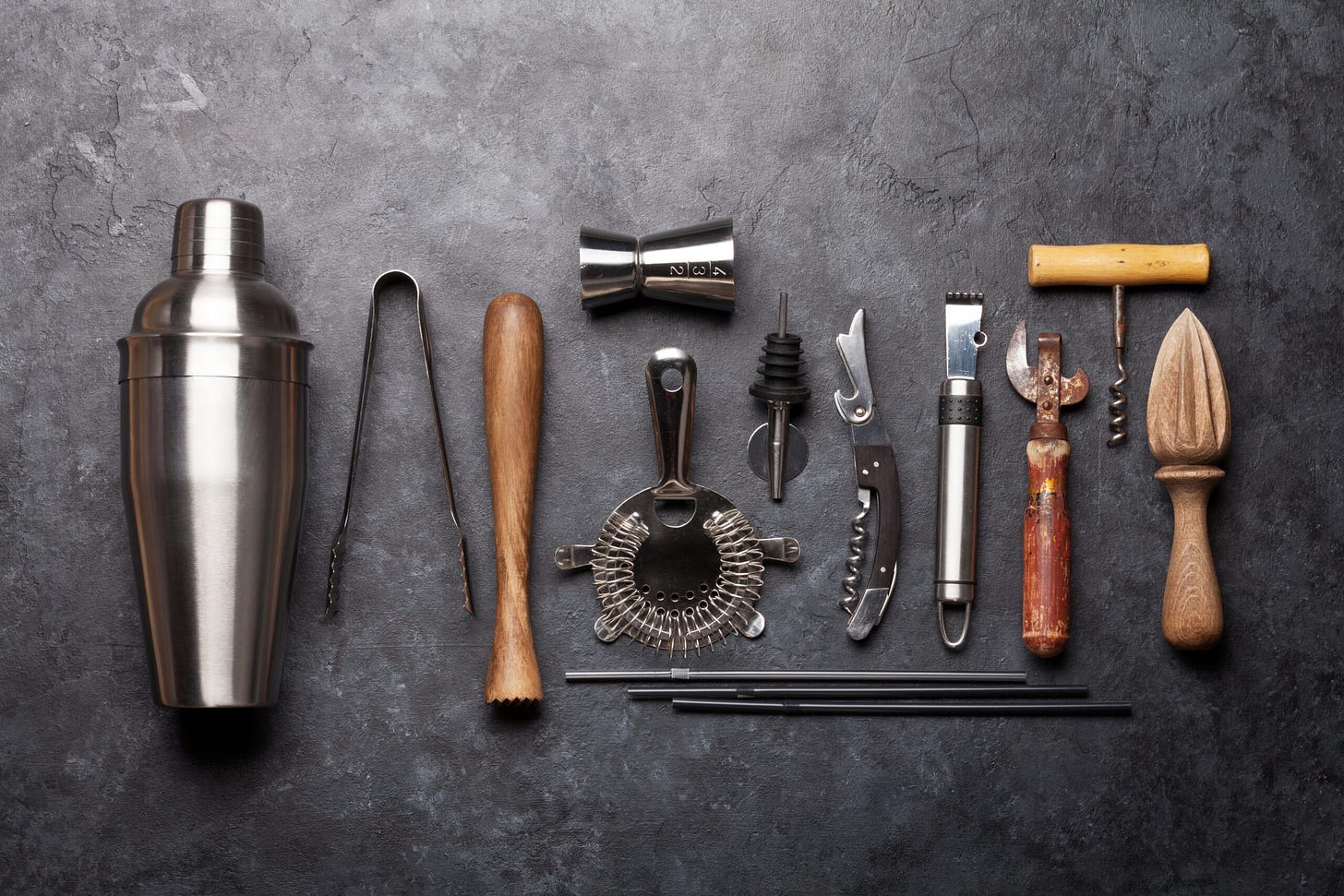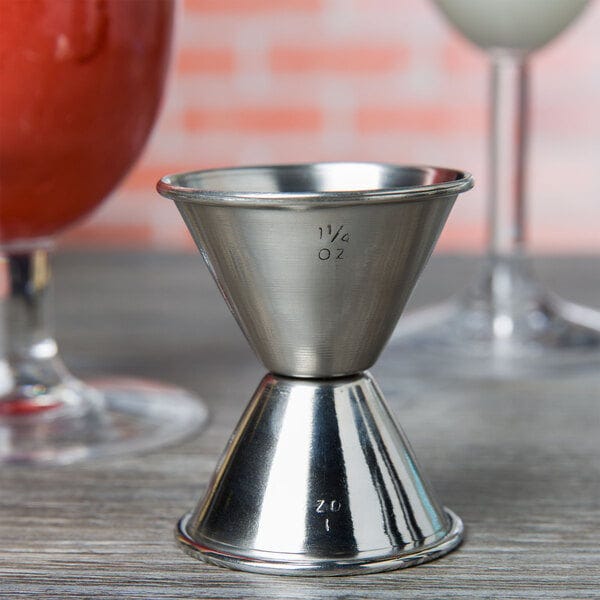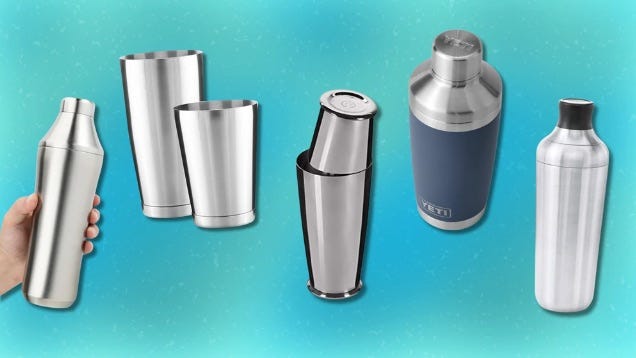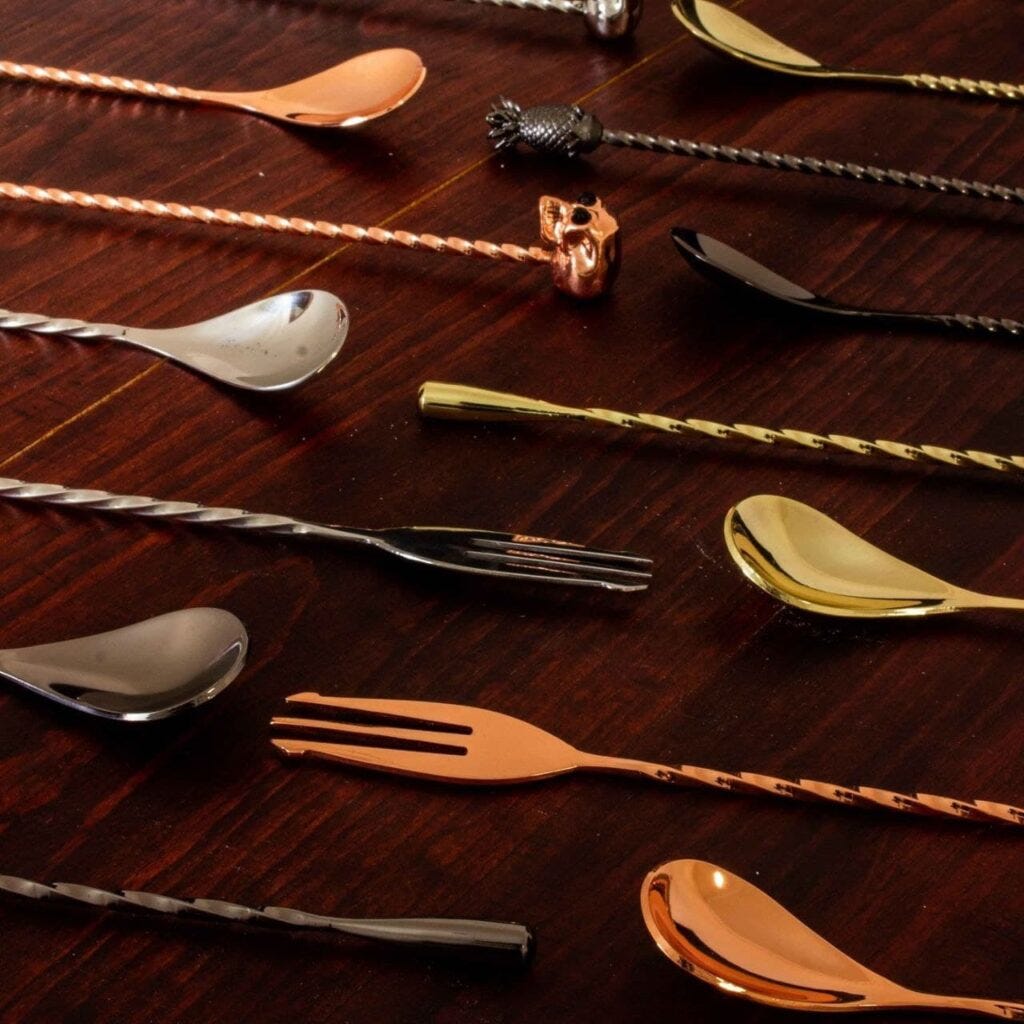I’m a gadget lover.
I love buying well-made, obscure tools that only do one thing, but do it very well. One of my great loves is working on vintage tube amplifiers, guitars and basses and there is no shortage of opportunity to drop serious coin on specialized tools for that adventure.
Home bartending can be a similar adventure. While the temptation exists to think that having that special bar tool, precision bitters bottle or other esoteric device will make your cocktails better, it’s not really the case. However, there are a few tools that will make your life as a cocktail constructor a lot more enjoyable, and you should invest in those. Fortunately there are only a few, and even good ones will not set you back that much. In this article I’ll describe the few gadgets you really should have when starting out.
One tool you will use in damn near every cocktail you make is a jigger. Cocktails are recipes, and you’re going to need to measure booze, syrup and citrus to get them right. In fact, measuring is one of the most important keys to making consistent cocktails. By the way, the speed pour, while it may look neat and might impress the weak-minded, in much the same way that a Jedi mind trick can fool a stormtrooper, will not give a consistent measure from drink to drink, no matter how good you think you are at it. These aren’t the ‘droids you’re looking for - measure your ingredients.
Jiggers come in a variety of shapes and sizes, and I’ve tried a few of them. My first jiggers were a set of short, wide, stainless steel cones that only gave two measures, one for each half of the jigger. For example, one jigger might have 3/4 oz on one side and 1 1/2 oz on the other. This seemed like a good idea at the time, until I started having to use two or three different jiggers to make a few different cocktails. More than once I grabbed a jigger that I thought would give me a particular measure, only to find that I used the wrong one.
The type of jigger that I like working with is a taller, narrower version that has multiple, well-scored lines for different measures on the inner surfaces. Having multiple measures makes it much easier to make drinks using only one tool, and the taller, narrower build makes for less impact if you miss the measurement line (San Diego Mixology has a really good explanation of why this is true HERE.). Accuracy really counts when it comes to making a good drink every time, and the tall, narrow jiggers make it easier for you to pour your ingredients accurately, every time.
Now that you can measure out the stuff you need to make your cocktails, you’re going to need something to make them in. There are a couple of different strategies you can employ here.
First, ask yourself, what kind of drinks are you interested in making? There are really two types: drinks that you build in a vessel of some type, usually glass, and stir until they are chilled and properly diluted, or those that you build in a vessel of some type and shake with ice until they are, you guessed it, chilled and properly diluted. There are a couple different variations on each of these techniques, but for the vast majority of cocktails, you’ll either be stirring or shaking.
If you’re planning to start out making mainly drinks that require either one or the other of these techniques, then it might make the most sense to invest in either a mixing vessel of some type for making stirred drinks (manhattans, martinis, negronis, etc.), or a set of shaker tins for drinks that need to be shaken (daiquiris, mai tais, margaritas, etc.). The good news is that you can find quality examples of each of these tools that won’t require a significant outlay of cash. You might also find that you have already have something that can act as a stand-in, especially for the glass mixing vessel. Have a heavy, thick, pint glass for drinking beer? That’ll work, you just have to be careful when stirring that the glass doesn't tip over as, due to the narrow bottom and wide mouth of that type of glass, they aren’t as stable as purpose-built mixing vessels. You can also use one-half of a set of shaker tins to make stirred drinks, but know that the metal of the shaker won’t respond the same way to ice as the glass of a mixing vessel, so you’ll need to take that into account (a solution to this could be a Boston Shaker - more on that later).
As far as shaker tins go, there are a few types, tin-on-tin, cobbler or Parisian, and the Boston shaker (see, I told ya we’d talk about this again). Each of these types of shakers has advantages and disadvantages.
In my personal opinion, I’d avoid the Parisian/cobbler style shaker for one simple reason: as those things cool down, at they are want to do when full of ice, the metal is going to contract, and the tops become damn near impossible to get off. Please, feel free to live vicariously through me on this one. Not a big deal if you’re making one cocktail for yourself, but if you have a bunch of friends who happen to be thirsty, it can become an issue.
Between the other two types, tin-on-tin and the Boston style, there are certain advantages and disadvantages. The additional weight of the Boston style, owing to half the device being glass, can be a bit much to shake continually. On the other hand, The glass section of the Boston shaker can do double duty as a mixing vessel, and it does a much better job of that than half of a tin shaker would. The tin-on-tin style shakers are lighter and less prone to producing fatigue with prolonged shaking, and they tend to seal a bit better as well.
Once you get everything stirred or shaken, nicely chilled and diluted, you need to get it in a glass, and you’re going to strain nearly every cocktail that you make. While there are a few cocktails that you might shake and dump without straining, just as you might from time-to-time build certain types of drinks in a glass, then add a large rock of ice and stir and serve in the same glass, most of the time you’ll be straining, either from your mixing vessel or shaker tin into a new glass with fresh ice.
As with everything else relating to bar tools, there a a few different types of strainers. The three most common are the Hawthorne strainer, the Julep strainer and the fine mesh strainer. Sometimes two types of strainers are used simultaneously.
If you’re investing in one type of strainer initially, I’d go with the Hawthorne style, as pictured above. It’s the most versatile as you can use it with really any type of drink, stirred or shaken, and it’s the easiest to use. It has a coil of metal, like a spring, that does the bulk of the fine straining, while the metal top helps to keep big chunks of ice a citrus pulp where they belong. Finding a hawthorne with a tightly coiled spring will give you a very nice strain and keep the unwanted stuff out of your cocktail
Finally, if you’re going to be making stirred drinks, it stands to reason that you’ll need something with which, to, well, stir. You need a bar spoon, friends!
While there are a variety of bar spoon types available, they all perform two basic functions, they allow you to make measurements of small amounts of liquids, and they make it easier to stir drinks in a mixing vessel that is full of ice. There are a number of other actions that can be performed with a bar spoon, some of which are dependent on its design. I have a couple different bar spoons, of the “Japanese” style, with a twisted, stainless steel shaft and a weighted teardrop on the end opposite the spoon. For the type of drinks I’m making I find that this spoon takes care of all my needs, The only difference between the two is in their length. One is 12 inches and the other is 15 inches. I personally prefer the longer one but this is entirely a matter of what feels best in your hand. Do a little research to see what type of spoon might fit your particular mixing needs, and again, invest in a good one, because you’ll be using it a lot. It’s very important to find out how much liquid your chosen bar spoon holds if you’re using it to measure, as they vary from about 2.5 ml (1/2 teaspoon) to 5 ml (1 teaspoon), or even slightly larger.
So that’s it! You’re ready to start mixing up some tasty drinks. Sure, there are some other tools that you’ll eventually want to acquire, but these four will set you up to start experimenting with your own cocktail making process at home.









